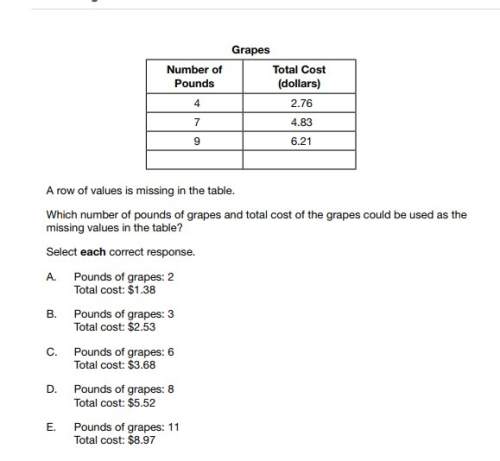If you place a 34-foot ladder against the top of a 30-foot building, how many feet will
the bo...

Mathematics, 26.03.2020 19:09 mimas76
If you place a 34-foot ladder against the top of a 30-foot building, how many feet will
the bottom of the ladder be from the bottom of the building?

Answers: 1
Another question on Mathematics

Mathematics, 21.06.2019 13:30
What are potential hypotheses (explanations) regarding why there are ecological equivalents between many metatherians and eutherians? discuss your hypothesis in terms of the processes that could lead to the current ecologies and distributions of metatherians and eutherians.
Answers: 2

Mathematics, 21.06.2019 14:30
Find the arc length parameter along the given curve from the point where tequals=0 by evaluating the integral s(t)equals=integral from 0 to t startabsolutevalue bold v left parenthesis tau right parenthesis endabsolutevalue d tau∫0tv(τ) dτ. then find the length of the indicated portion of the curve r(t)equals=1010cosine tcost iplus+1010sine tsint jplus+88t k, where 0less than or equals≤tless than or equals≤startfraction pi over 3 endfraction π 3.
Answers: 3

Mathematics, 21.06.2019 19:00
D(5, 7). e(4,3), and f(8, 2) form the vertices of a triangle. what is mzdef? oa. 30° ob. 45° oc. 60° od 90°
Answers: 1

Mathematics, 21.06.2019 21:30
In a test for esp (extrasensory perception), the experimenter looks at cards that are hidden from the subject. each card contains either a star, a circle, a wave, a cross or a square.(five shapes) as the experimenter looks at each of 20 cards in turn, the subject names the shape on the card. when the esp study described above discovers a subject whose performance appears to be better than guessing, the study continues at greater length. the experimenter looks at many cards bearing one of five shapes (star, square, circle, wave, and cross) in an order determined by random numbers. the subject cannot see the experimenter as he looks at each card in turn, in order to avoid any possible nonverbal clues. the answers of a subject who does not have esp should be independent observations, each with probability 1/5 of success. we record 1000 attempts. which of the following assumptions must be met in order to solve this problem? it's reasonable to assume normality 0.8(1000), 0.2(1000)%30 approximately normal 0.8(1000), 0.2(1000)% 10 approximately normal srs it is reasonable to assume the total number of cards is over 10,000 it is reasonable to assume the total number of cards is over 1000
Answers: 1
You know the right answer?
Questions


Mathematics, 31.03.2021 04:10



Mathematics, 31.03.2021 04:10

Mathematics, 31.03.2021 04:10

English, 31.03.2021 04:10


Mathematics, 31.03.2021 04:10

Mathematics, 31.03.2021 04:10




Mathematics, 31.03.2021 04:10

Spanish, 31.03.2021 04:10





Mathematics, 31.03.2021 04:10




